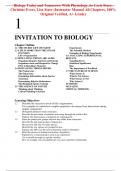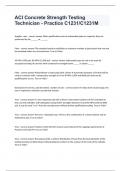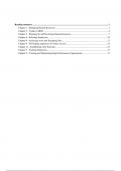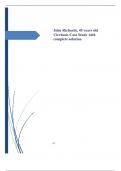© 2021 Cengage. All Rights Reserved. May not be scanned, copied or duplicated, or posted to a publicly accessible website, in whole or in part. 1 ________________________________ ________________________________ ____________________________ INVITATION TO BIOLOGY Chapter Outline 1.1 THE SECRET LIFE OF EARTH 1.2 LIFE IS MORE THAN THE SUM OF ITS PARTS Life’s Organization 1.3 HOW LIVING THINGS ARE ALIKE Organisms Require Nutrients and Energy Organisms Sense and Respond to Change DNA Is Hereditary Material 1.4 HOW LIVING THINGS DIFFER The Prokaryotes The Eukaryotes Organizing Information about Species Taxonomy Determining Relative Relatedness The Biological Species Concept 1.5 THE SCIENCE OF NATURE Thinking about Thinking Critical Thinking in Science Experiments The Scientific Method Examples of Biology Experiments 1.6 ANALYZING EXPERIMENTAL RESULTS Sampling Error Statistical Significance Bias The Importance of Feedback 1.7 THE NATURE OF SCIENCE What Science Is What Is Not Science What Science Is Not Why Science? SUMMARY SELF -QUIZ CRITICAL THINKING
Learning Objectives 1.2 Describe the successive levels of life’s organization . Use examples to explain how complex properties can emerge from interactions among simpler components. 1.3 Distinguish producers from consumers . Describe the movement of nutrients and energy through the world of life. Explain why homeostasis is important for sustaining life. 1.4 Name the prokaryotic groups and how they differ from eukaryotes. Describe the four main groups of eukaryotes. Discuss how and why we name species. Describe the way species are grouped in taxa. Explain why DNA can be used to determine relative relatedness. 1.5 Detail the process of making and testing a hypothesis . Explain how a control group is used in an experiment. Use a suitable example to explain variables. Give an example, real or hypothetical, of a cause -and-effect relationship. Biology Today and Tomorrow With Physiology, 6e Cecie Starr, Christine Evers, Lisa Starr (Instructor Manual All Chapters, 100% Original Verified, A+ Grade) Chapter 1: Invitation to Biology 2 1.6 Use an example to explain why generalizing results from a subset can be problematic in research . Describe statistical significance. Explain the role of critical thinking in making science a self -correcting process. 1.7 Name the criteria that qualify a hypothesis for status as a scientific theory. Explain what happens to a theory when data arise that are inconsistent with it. Identify some areas of inquiry that science does not address. Discuss some ways to identify pseudoscience. Key Terms animals archaea atom bacteria biology biosphere cell community consumer control group critical thinking data development DNA ecosystem eukaryotes experiment experimental group fungi genus growth homeostasis hypothesis inheritance law of nature model molecule nutrient organ organism organ system photosynthesis plants population prediction probability producer prokaryotes protist pseudoscience reproduction sampling error science scientific method scientific theory species statistically significant taxon taxonomy tissue traits variable
Lecture Outline 1.1 The Secret Life of Earth A.There are organisms on Earth that have yet to be discovered and categorized .
B.Biology is the scientific study of life in order to make sense of the world around us.
1.2 Life Is More Than the Sum of Its Parts A.Biologists view life in increasingly inclusive levels of organization and complexity.
1.Atoms are the basic building blocks for all matter.
2.Molecules are unions of individual atoms.
3.Cells are the smallest unit of living things that can carry out the basic functions of life.
4.Organisms are collections of cells that work together and create complex interactions.
Organisms can exhibit several levels of interactions .
a.Tissues are groups of cells that work together to complete a process.
b.Organs are groups of tissues that work together.
c.Organ systems are groups of organs that work together to complete a complex process.
5.Populations are collections of the same type of species living in a given area.
6.Communities are all of the living populations in a given area.
7.An ecosystem includes all the living populations and the environment that the communities
interact with.
8.Finally, a biosphere encompasses all the different ecosystems on Earth. Chapter 1: Invitation to Biology 3 © 2021 Cengage. All Rights Reserved. May not be scanned, copied or duplicated, or posted to a publicly accessible website, in whole or in part. B.Life is more than the sum of its individual parts. That is to say that there are emergent
properties or characteristics that arise out of the complexity of the interactions of a system’s
component parts.
1.3 How Living Things Are Alike A.Life is hard to define ; however, there are several characteristics that all living things have in
common .
1.All organisms consist of one or more cells.
2.All living things require energy and the raw materials required to maintain energy supplies.
a.Energy is the capacity to do work.
b.Nutrients are substances that an organism cannot make for itself but that the organism
requires for growth and survival.
c.Producers make their own food using energy and raw materials directly from the
environment. Plants are an example of a producer ; plants use a process called
photosynthesis that uses energy from the sun to produce sugars .
d.Consumers cannot make their own food; instead , they feed on other organisms for
food.
e.Nutrients cycle between producers and consumers , but energy does not. Energy flows
in one direction from the sun , through producers , and finally to consumers.
3.All living things have the ability to sense and respond to changes in the environment.
a.Homeostasis is the process through which organisms maintain conditions of
temperature, pH, concentration, and so on in their internal environments that
favor cell survival.
4.All living things have the ability to grow and reproduce.
a.Information about the variety of traits that exist between individuals is encoded within
the DNA.
b.Inheritance is the transmission of DNA from parents to offspring through a mechanism
called reproduction.
1.4 How Living Things Differ A.Various classification systems exist. This text uses a three -domain system: Bacteria, Archaea,
and Eukarya.
1.Bacteria and archaea are single -celled prokaryotes. Prokaryotes have no nucleus.
2.All other organisms are eukaryotes: organisms with a nucleus.
a.Protists are either single -celled or multicellular, producers or consumers.
b.Fungi are multicellular decomposers that complete digestion extracellularly.
c.Plants are multicellular producers that use photosynthesis to harvest sunlight for
conversion into chemical energy.
d.Animals are multicellular consumers that acquire nutrition by feeding on other
organisms.
B.All organisms have a two -part name , standardized by the Linnaean System .
1.First is its genus, which is a group of organisms that share a unique set of features.
2.Second is its species name, which represents a population of interbreeding organisms.
C.Taxonomy is the practice of naming, describing, and classifying species.
1.Individuals of a species share a unique set of inherited traits.
2. Species are ranked into ever more inclusive categories based on shared traits.
a.Species is the lowest rank, or taxon, of living things.
b.The taxon above species are genus, family, order, class, phylum, kingdom, and
domain.
D.Scientists use anatomy, distribution, and biochemical information to compare traits and
differentiate between and within species. Chapter 1: Invitation to Biology 4 © 2021 Cengage. All Rights Reserved. May not be scanned, copied or duplicated, or posted to a publicly accessible website, in whole or in part. 1. The fewer differences there are between species, the closer the relationship. 2. The discovery of new information changes the way we distinguish and group species. 3. The biological species concept defines a species as one or more groups of individuals that can interbreed, produce fertile offspring, and do not interbreed with other groups. a. This concept cannot classify extinct organisms or prokaryotes. b. “Species” is a convenient but artificial construct. 1.5 The Science of Nature A. Science is the systematic study of the living world. Science is bound by the basic limitation of observability. B. The goal of scientific inquiry is to remove bias and subjectiveness from observation and analysis of data. C. Critical thinking is crucial to the scientific process. D. Scientific study includes several common practices . 1. Observation of natural phenomena. 2. Framing questions about observations. 3. Doing background research and develop ing a hypothesis, or testable answer , for the question. 4. Using the hypothesis to generate an if –then process: If the hypothesis is this, then we predict this should happen. 5. Devis ing a method for testing the prediction. 6. Assess ing the data from the testing. 7. Report ing the findings. E. This is not a rigid process; there are many ways of entering into scientific inquiry and many different starting points. F. Experimentation is the best way to test hypotheses or falsify predictions. G. Experiments are used to test individual variables; good experimental design seeks to reduce the number of variables that may affect the outcome. This can be problematic because biological systems have many interacting variables. H. In an experiment , there are two groups: an experimental group , which receives a treatment , and a control group , which does not receive the treatment for comparative purposes. Therefore, changes between the two groups can be attributed to the treatment the experimental group receives. I. The process of forming and testing a hypothesis and making conclusions is called the scientific method. 1. The scientific method is not a direct, straight -line process. 1.6 Analyzing Experimental Results A. Sampling Error: Scientists can never test every case of a phenomenon. Instead they study a subset, or sample, of the phenomenon. 1. Sampling errors represent the difference between how the phenomenon was measured in the sample population and how the phenomenon exists in the whole population. 2. Smaller samples have larger sampling errors. 3. Error bars on graphs represent that error. B. Analysis of experimental data often includes statistical calculations of the probability of the expected outcome occurring. 1. Results are said to be statistically significant if it is highly unlikely that they occurred by chance alone. 2. Bias in interpreting results: Researchers try to design experiments that test one variable objectively.







